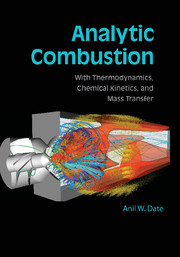Book contents
- Frontmatter
- Contents
- Preface
- Symbols and Acronyms
- 1 Introduction
- 2 Thermodynamics of a Pure Substance
- 3 Thermodynamics of Gaseous Mixtures
- 4 Chemical Equilibrium
- 5 Chemical Kinetics
- 6 Derivation of Transport Equations
- 7 Thermochemical Reactors
- 8 Premixed Flames
- 9 Diffusion Flames
- 10 Combustion of Particles and Droplets
- 11 Combustion Applications
- APPENDIX A Thermochemistry Data
- APPENDIX B Curve-Fit Coefficients for Δhc, Tad, Kp, Cp, h, and s
- APPENDIX C Properties of Fuels
- APPENDIX D Thermophysical and Transport Properties of Gases
- APPENDIX E Atmospheric Data
- APPENDIX F Binary Diffusion Coefficients at 1 atm and T = 300K
- Bibliography
- Index
4 - Chemical Equilibrium
- Frontmatter
- Contents
- Preface
- Symbols and Acronyms
- 1 Introduction
- 2 Thermodynamics of a Pure Substance
- 3 Thermodynamics of Gaseous Mixtures
- 4 Chemical Equilibrium
- 5 Chemical Kinetics
- 6 Derivation of Transport Equations
- 7 Thermochemical Reactors
- 8 Premixed Flames
- 9 Diffusion Flames
- 10 Combustion of Particles and Droplets
- 11 Combustion Applications
- APPENDIX A Thermochemistry Data
- APPENDIX B Curve-Fit Coefficients for Δhc, Tad, Kp, Cp, h, and s
- APPENDIX C Properties of Fuels
- APPENDIX D Thermophysical and Transport Properties of Gases
- APPENDIX E Atmospheric Data
- APPENDIX F Binary Diffusion Coefficients at 1 atm and T = 300K
- Bibliography
- Index
Summary
Progress of a Chemical Reaction
In the previous chapter, we dealt with postulated products of a hydrocarbon chemical reaction for Φ ≤ 1 and for Φ > 1. The latter case was to be treated specially because it involves postulation of a two-step reaction mechanism (see Equations 3.46 and 3.47). The main point is that the postulated product composition was so far sensitized only to the value of Φ.
In reality, the product composition does not conform to the one postulated for any value of Φ. This is because, in addition to Φ, the product composition is governed by p, T, and the rate at which a reaction proceeds. As we have repeatedly mentioned, the central problem of combustion science is to predict product compositions accurately under conditions obtaining in practical devices. This inquiry into the most likely product composition is structured with increasing refinements in the following manner:
Product formation is determined by Φ only.
Product formation is determined by Φ, p, and T only.
Product formation is determined by Φ, p, T, and chemical kinetics only.
Product formation is determined by Φ, p, T, chemical kinetics, and fluid mixing.
The first type of product formation has already been discussed. In this chapter, our aim is to determine the effect of Φ, p, and T on the product formation process (second item in the list above).
- Type
- Chapter
- Information
- Analytic CombustionWith Thermodynamics, Chemical Kinetics and Mass Transfer, pp. 70 - 89Publisher: Cambridge University PressPrint publication year: 2011



